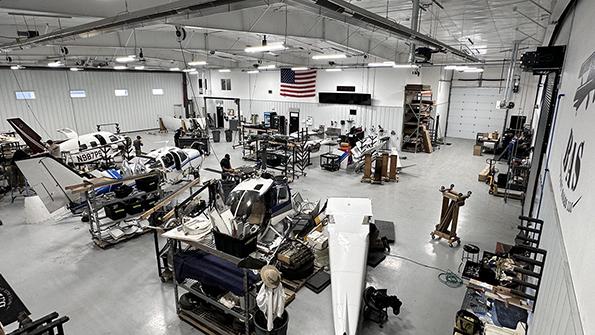
While hardly a subject of keen general interest, the broken links in the industrial supply chain are impacting manufacturers, service providers and consumers seemingly universally. All aviation segments are affected.
If Boeing cannot get the widgets it needs to deliver a $200 million transport on time, what chance do owners of broken flivvers have to get the parts needed for slipping the surly bonds once again? One answer may surprise.
I’ve owned several aircraft, including a 1975 Rockwell Commander 112A. A stylish two-door, four-seat, 130-kt., retractable-gear aircraft, it was fully instrumented and easy to handle. But were it mine still and, say, a distracted tug driver destroyed a landing gear strut, what then? After all, the model is nearly five decades out of production, and its maker is a ghost.
Well, it turns out I could telephone, text, email or go online and, if I was satisfied with what I learned there, a replacement strut could be in my hangar within a day or two for $3,050. That could happen because the part is not a dubious promise on a slowed production schedule but is extant and in stock, having been made years ago and installed on another aircraft that no longer exists—at least not as a whole.
Welcome to the world of salvage, deconstruction, restoration and resale. There is nothing new about reuse of aircraft parts. The practice began in 1905 when Orville and Wilbur Wright applied elements of their Flyer II to create the Flyer III. There have been a host of aviation recyclers since, notably including the U.S. Air Force.
One small but highly regarded entity among commercial practitioners is BAS Part Sales. The 26-employee company has a global clientele that includes fleet operators, repair shops, individuals and even a movie studio. It services them all from its main 48,000-ft.2 warehouse/hangar/office and 10-acre storage yard complex at Greeley-Weld County Airport, 50 mi. north of Denver.
An outgrowth of Beegles Aircraft Service, which began operation at Greeley in 1946, the now-independent, 12-year-old company stocks in excess of 60,000 parts ranging from bolts and yokes to engines, avionics and entire fuselages. Each part is cleaned, photographed, cataloged and listed on its website, along with its price, and comes with free shipping and a 90-day money-back guarantee.
The tech-savvy company previously had focused on light general aviation models, primarily Cessna, Beech, Piper, Mooney and Cirrus airplanes and Robinson Helicopters. But that expanded dramatically in early March with its purchase of White Industries of Bates City, Missouri, some 30 mi. east of Kansas City.
The BAS inventory derives from several sources, including those of former competitors, as well as the 125-150 aircraft it annually purchases from insurance companies and individuals and disassembles. A Piper Malibu, for example, can be transformed into 2,000 parts or more, with just a painted shell remaining.
But the White acquisition represents a seismic shift in the company’s stockpile. Based at a privately owned, public-use facility with a single, 4,400-ft. gravel runway, the 67-year-old recycler has 90,000 ft.2 of warehouse hangars jam-packed with some 500,000 parts of aircraft ranging from vintage singles to Learjets, Hawkers, Citations, King Airs and even regional airliners. Beyond that, it has 2,000 airframes, some stripped but others nearly complete, spread across 170 airport acres.
In assessing the acquisition, BAS President Jared Boles marveled at “the sheer extent of the inventory we’ll have to offer.”
Digesting it all likely will take years, but the work has already begun. BAS retained and retrained four White employees, added two more and plans further hires. Beyond that, mechanics recently stripped 101 aircraft at the renamed “BAS Kansas City” facility and trucked the parts to Greeley for processing and resale.
The expansion is likely to further enhance BAS’ reputation, one buoyed by nearly 600 five-star Google ratings. Mike Barnett is among the many satisfied customers. An aviation claims adjuster, pilot and mechanic, he is nearly finished rebuilding his 1961 Beech Travel Air, to which BAS contributed. “They just seemed to have the parts I needed,” he says. Plus one more.
To complete the project, he wanted a rare Travel Air emblem for placement on the fuselage, but the talisman eluded him, a fact he mentioned offhandedly to a BAS associate at a convention both were attending. Two days later, the fellow called with the unexpected and welcome news that he had located three of them—one new and two recycled, naturally. Barnett’s reborn and transformed twin would have its capstone after all.
